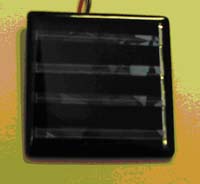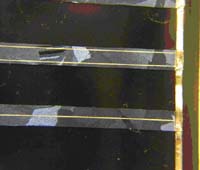 |
Bad Path Light
|
|
On one of my early morning walks, I
spotted a broken solar powered path light, which had been tossed out into the
weeds near a railroad track. I picked up the thing and put it in my pocket.
I thought some of the parts may come in handy. When I got home and I took a
closer look at the thing, I noticed something strange. As shown below, at
first glance, the 1.75 inch by 1.75 inch photovoltaic panel looked like many of
the other devices Iíve seen on solar powered path lights. It looks like four
overlapping solar cells with their shinny metallic collecto |
|
| However, when I looked at the
thing a bit closer, I saw that instead of filling in the 3 square inch
available area with solar cells, this unit cheated by using four skinny 0.13
inch x 1.6 inch cells as shown below. This yielded an active area of
only 0.83 square inches. This corresponded to a fill factor of only 28%.
This seems to be a very common
technique employed at Chinese manufacturers. They make stuff that just
barely works and no more. They use the absolute minimum of materials,
which of course means poorer overall quality and less than perfect
performance. |
 |
|
 |
I measured the
open circuit voltage of the solar panel at 2.3v and measured the short
circuit current at 37ma in direct sunlight. I started to trace out the
circuit used in this path light assembly but because some of the circuit was
missing, I could only guess at the complete design. It appears that
they use a 1N5819 schottky diode between the solar panel and a single 1.2v
NiMH
rechargeable AA cell. Figuring about 0.35v drop for the schottky
diode, that would leave 1.95v to charge the NiMH
cell. That seems
about right. The 1.2 volts from the single NiMH
cell is too low to power any
LED directly, so they used a transistorized (no ICs) DC to DC converter, to
boost the voltage high enough to drive a single, most likely yellow, LED.
During sunlight charging, the four solar cells act as a constant current
source, feeding a maximum of 37ma of current to the single battery cell.
Other solar powered path lights use a |
|
| higher solar panel voltage, which
can charge two AA cells. The advantage of two cells is that the voltage is
high enough to drive a LED directly. The LED driver circuit is usually
nothing but a current limiting resistor connected to a simple circuit, which turns
off the LED when there is sunlight. This is day/night switch is typically
done by monitoring the voltage from the solar cells, switching in the cells in
daylight. The thing I picked up from the weeds seemed to be a cheap knock-off of
the higher quality units. But, would this thing work? |
Letís make a few assumptions.
Letís say that this thing was placed in a sunny area and got a full 6 hours of
sunlight during the day. With a current of 37ma, the current pumped into the
rechargeable battery would be 37 x 6 or 222 milliamp-hours into a 1.2v battery
cell. Top quality NiMH
AA cells have a rating of 2500ma-hours.1.2 volts times
0.22 Amps equals 0.27 watt-hours of maximum supplied energy from the solar panel
per day. Now, letís assume that the yellow LED had a forward voltage drop of 2
volts at 20ma for a power or 0.04 watts, and was driven by this battery. We
will not even factor in the losses of the DC to DC converter or the battery
charging losses. If we divide 0.27 watt-hours by 0.04 watts, we get 6.75
hours. That means that the energy harvested during those 6 hours of sunlight would
be enough to keep the path light lit for about 6 hours at night if the LED were
driven at a reasonable 20ma of current. At least here in Colorado, that
would not be long enough to make it through the night. If the sun went down
at 5:00 in the afternoon, on a winter day, the LED path light would turn on but
would be off again by 11:00 PM. The battery would be completely dead. Maybe
they drive the LED with less current to extend the operating time more than 6
hours. But, overall, I think the design stinks. If the solar panel had
a 90% fill factor instead of only 28% the light would be brighter and make it all
the say through a long dark night with some power to spare. |
| Overall, I would say that this
light I found was a bad design. The manufacturer was trying to save
money by using only one rechargeable cell, and a very small solar cell area.
Sure, the light works but not for very long.
The next time you are shopping for path lights,
look at the solar panel and only buy units that have full size solar cells. |
 |
|
|
|